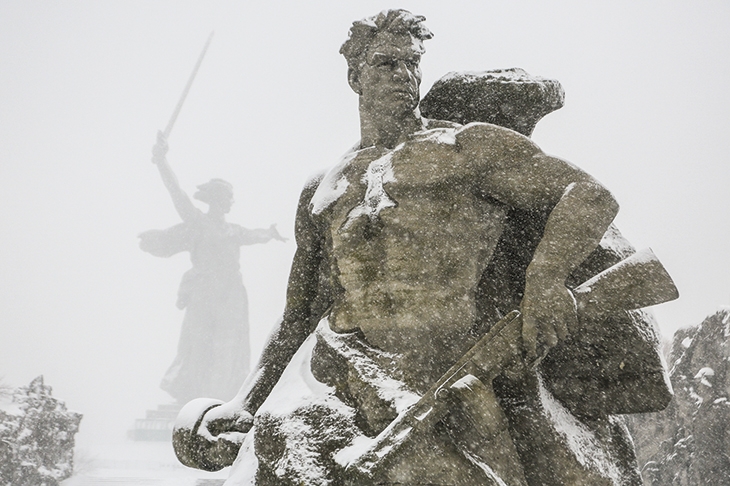Most monuments are literally set in stone — or cast in bronze to better survive the weather. Being enduring, they arguably become ‘prisoners of history’, as this fascinating series of essays by Keith Lowe is titled. Conversely, perspectives are like the weather, constantly changing, as relationships between and within nations, and views on social and moral norms, shift over time, as we are seeing particularly at present. The inherent tension between the human desire for monumental permanence, especially after the upheaval of war, and the natural transience of social values, proves fertile ground for this examination of the lessons that can be drawn from second world war monuments around the world.
Lowe applies his critical gaze to 25 of them, from 16 countries, marshalled into five sections: heroes, martyrs, monsters, apocalypse and rebirth. These are the ideas, he argues, that underpin our collective memory of the second world war. It is soon clear how interconnected these concepts are; but more fascinating are the paradoxes he reveals. Over time, heroes once admired for their strength actually become the most vulnerable figures, Lowe contends, inevitably open to criticism as power shifts, and often conferring difficult noblesse oblige responsibilities on their home nations. Once the ultimate sacrifice has been made, however, ‘a martyr is forever’, and ‘a nation of martyrs is free to be as selfish as it wishes’.
There are poignant shrines of remembrance, and others defiled by the inclusion of war criminals
Such a provocative perspective makes Lowe’s choice of monuments important. The well-balanced range here enables the retelling of some remarkable war stories, while also providing fascinating insights into the ways different nations have remembered or denied issues around national identity and the glory and horrors of war. There are memorials erected by various governments on home territory and on foreign soil; there are poignant shrines, started as spontaneous acts of remembrance; and others defiled by the inclusion of war criminals. To Lowe’s credit, he includes memorials to atrocities carried out by both the Nazis and the Allies, and looks as critically at monuments to ‘heroes’ as he does at those to ‘monsters’.
First up is the Soviet Union’s ‘The Motherland Calls’, a complex of statues topped by a vast representation of Mother Russia herself, greater than any enemy or national loss. More controversial is the Soviet monument in Warsaw. US monuments are just as contentious, such as the Marine Corps Memorial, inspired by the famous photograph of marines planting the Stars and Stripes on Japanese soil, leading to reflections on how different nations regard their flags. And critical essays follow on the British Bomber Command memorial, ‘a group of heroes who appear to have nothing heroic to do’; the National Monument in Amsterdam, presenting the country’s suffering with no reference to Dutch Jews; and the Hungarian monument to Victims of the German Occupation, ‘a symbol of national hypocrisy’.
But Lowe does not always hit the mark. His contention about the ‘genuine debt’ Poland owes to the Soviet Union, supported by mention of the Soviet release of Polish prisoners and exiles in 1941 but with no reference to the thousands already murdered or the later repressions, would shock many Poles. Perhaps it is inevitable that a book aiming to provoke fresh thought sometimes feels over-zealous. It is hard to accept Lowe’s contention that the Auschwitz site not only memorialises victims but also perpetrators, so that visiting it ‘makes monsters of us all’; or that Berlin’s attempt to erase all sign of Hitler’s bunker is reminiscent of the annihilation of villages and their inhabitants during wartime atrocities.
Questioning even the most dearly held positions is what gives this book its power, however, and Lowe also makes some courageous choices. After reading some hard-hitting essays on the horrors of war, I was looking forward to a gentler, more uplifting section on rebirth. In fact these last essays are just as challenging, with their censure of the ‘hopelessly dated’ mural in the UN Security Council chamber; the sad failure of Coventry’s rebirth as a centre for reconciliation; and a robust essay on the balcony at the end of the Holocaust museum at Yad Vashem, which looks out over the Judean hills in a way that is ‘faintly disingenuous’, given that these hills are the site of an atrocity undertaken by Jewish paramilitary forces against Arab civilians.
Every book, like every monument, has a context. Interrogation often reveals as much about the author’s times and perspective as it does about their chosen subject. In a sense, Lowe’s book is just as much a prisoner of history as the monuments he discusses, and it will be interesting to see how it, too, will stand the test of time. For now, this is some of the most thought-provoking writing about the second world war that I have read for a long while. I could happily review each essay, recognising a fair bit of brilliance, and arguing about interpretations and omissions. Instead, I suggest you buy a copy and interrogate it yourself.






Comments